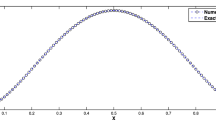Abstract
Stability for nonlinear convection problems using centered difference schemes require the addition of artificial dissipation. In this paper we present dissipation operators that preserve both stability and accuracy for high order finite difference approximations of initial boundary value problems.
Similar content being viewed by others
REFERENCES
Abarbanel, S., and Ditkowski, A. (1997). Asymptotically stable fourth-order accurate schemes for the diffusion equation on complex shapes. J. Comput. Physics 133, 279–288.
Carpenter M. H., Gottlieb, D., and Abarbanel, S. (1994). The stability of numerical boundary treatments for compact high-order finite-difference schemes. J. Comput. Phys. 108(2).
Carpenter, M. H., Nordström, J., and Gottlieb, D. (1999). A stable and conservative interface treatment of arbitrary spatial accuracy. J. Comput. Phys., 148.
Eriksson, L.-E. (1984). Boundary Conditions for Artificial Dissipation Operators, Technical Report FFA TN 1984-53, The Aeronautical Research Institute of Sweden, Aerodynamics Department, Stockholm, Sweden.
Erlebacher, G., Hussaini, M. Y., and Shu, C.-W. (1997). Interaction of a shock with a longitudinal vortex. J. Fluid. Mech. 337, 129–153.
Gustafsson, B. (1981). The convergence rate for differnce approximations to general mixed initial boundary value problems. SIAM J. Numer. Anal. 18(2), 179–190.
Kreiss, H.-O., and Scherer, G. (1974). Finite element and finite difference methods for hyperbolic partial differential equations. In Mathematical Aspects of Finite Elements in Partial Differential Equations, Academic Press.
Kreiss, H.-O., and Scherer, G. (1977). On the Existence of Energy Estimates for Difference Approximations for Hyperbolic Systems, Technical report, Dept. of Scientific Computing, Uppsala University.
Mattsson, K. (2003). Boundary procedures for summation-by-parts operators. J. Sci. Comput. 18.
Mattsson, K., Svärd, M., and Nordström, J. (2002). Stable and Accurate Artificial Dissipation. Technical Report 2003-003, Department of Information Technology, Uppsala University, Uppsala, Sweden, http://www.it.uu.se/research/reports/2002-003/.
Nordström, J., and Carpenter, M. H. (1999). Boundary and interface conditions for high order finite difference methods applied to the Euler and Navier–Stokes equations. J. Comput. Phys. 148.
Olsson, P. (1992). The Numerical Behavior of Stable High-Order Finite Diffrence Methods. Ph.D. Thesis, Uppsala University, Dep. of Scientific Computing, Uppsala University, Uppsala, Sweden.
Olsson, P. (1995). Summation by parts, projections, and stability I. Math. Comp. 64, 1035.
Petrini, E., Efraimsson, G., and Nordström, J. (1998). A Numerical Study of the Introduction and Propagation of a 2-d Vortex, Technical Report FFA TN 1998–66, The Aeronautical Research Institute of Sweden, Bromma, Sweden.
Strand, B. (1994). Summation by parts for finite difference approximations for d/dx. J. Comput. Phys. 110, 47–67.
Author information
Authors and Affiliations
Rights and permissions
About this article
Cite this article
Mattsson, K., Svärd, M. & Nordström, J. Stable and Accurate Artificial Dissipation. Journal of Scientific Computing 21, 57–79 (2004). https://doi.org/10.1023/B:JOMP.0000027955.75872.3f
Issue Date:
DOI: https://doi.org/10.1023/B:JOMP.0000027955.75872.3f




